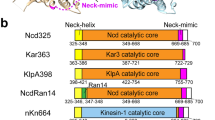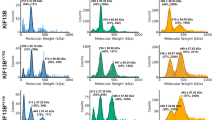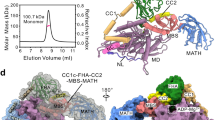Abstract
When not bound to cargo, the motor protein kinesin is in an inhibited state that has low microtubule-stimulated ATPase activity. Inhibition serves to minimize the dissipation of ATP and to prevent mislocalization of kinesin in the cell. Here we show that this inhibition is relieved when kinesin binds to an artificial cargo. Inhibition is mediated by kinesin’s tail domain: deletion of the tail activates the ATPase without need of cargo binding, and inhibition is re-established by addition of exogenous tail peptide. Both ATPase and motility assays indicate that the tail does not prevent kinesin from binding to microtubules, but rather reduces the motor’s stepping rate.
This is a preview of subscription content, access via your institution
Access options
Subscribe to this journal
Receive 12 print issues and online access
$209.00 per year
only $17.42 per issue
Buy this article
- Purchase on Springer Link
- Instant access to full article PDF
Prices may be subject to local taxes which are calculated during checkout





Similar content being viewed by others
References
Hurd, D. D. & Saxton, W. M. Kinesin mutations cause motor neuron disease phenotypes by disrupting fast axonal transport in Drosophila. Genetics 144, 1075–1085 (1996).
Coy, D. L. & Howard, J. Organelle transport and sorting in axons. Curr. Opin. Neurobiol. 4, 662–667 (1994).
Bloom, G. S. & Endow, S. A. Motor proteins I: kinesins. Protein Profile 2, 1109–1171 (1995).
Hirokawa, N. Kinesin and dynein superfamily proteins and the mechanism of organelle transport. Science 279, 519–526 (1998).
Howard, J. Molecular motors: structural adaptations to cellular functions. Nature 389, 561–567 (1997).
Hollenbeck, P. J. The distribution, abundance and subcellular localization of kinesin. J. Cell Biol. 108, 2335–2342 (1989).
Coy, D. L., Wagenbach, M. & Howard, J. Kinesin takes one eight-nanometer step for each ATP that it hydrolyzes. J. Biol. Chem. 276, 3667–3671 (1999).
Berne, R. M. & Levy, M. N. Physiology 3rd edn (Mosby, St Louis, 1993).
Saxton, W. M. et al. Drosophila kinesin: characterization of microtubule motility and ATPase. Proc. Natl Acad. Sci. USA 85, 1109–1113 (1988).
Hackney, D. D., Levitt, J. D. & Wagner, D. D. Characterization of alpha 2 beta 2 and alpha 2 forms of kinesin. Biochem. Biophys. Res. Commun. 174, 810–815 (1991).
Yang, J. T., Laymon, R. A. & Goldstein, L. S. A three-domain structure of kinesin heavy chain revealed by DNA sequence and microtubule binding analyses. Cell 56, 879–889 (1989).
de Cuevas, M., Tao, T. & Goldstein, L. S. Evidence that the stalk of Drosophila kinesin heavy chain is an alpha-helical coiled coil. J. Cell Biol. 116, 957–965 (1992).
Huang, T. G., Suhan, J. & Hackney, D. D. Drosophila kinesin motor domain extending to amino acid position 392 is dimeric when expressed in Escherichia coli. J. Biol. Chem. 269, 16502–16507 (1994).
Kozielski, F. et al. The crystal structure of dimeric kinesin and implications for microtubule-dependent motility. Cell 91, 985–994 (1997).
Kull, F. J., Sablin, E. P., Lau, R., Fletterick, R. J. & Vale, R. D. Crystal structure of the kinesin motor domain reveals a structural similarity to myosin. Nature 380, 550–555 (1996).
Yang, J. T., Saxton, W. M., Stewart, R. J., Raff, E. C. & Goldstein, L. S. Evidence that the head of kinesin is sufficient for force generation and motility in vitro. Science 249, 42–47 (1990).
Cyr, J. L., Pfister, K. K., Bloom, G. S., Slaughter, C. A. & Brady, S. T. Molecular genetics of kinesin light chains: generation of isoforms by alternative splicing. Proc. Natl Acad. Sci. USA 88, 10114–10118 (1991).
Gauger, A. K. & Goldstein, L. S. The Drosophila kinesin light chain. Primary structure and interaction with kinesin heavy chain. J. Biol. Chem. 268, 13657–13666 (1993).
Verhey, K. J. et al. Light chain-dependent regulation of kinesin’s interaction with microtubules. J. Cell. Biol. 143, 1053–1066 (1998).
Skoufias, D. A., Cole, D. G., Wedaman, K. P. & Scholey, J. M. The carboxyl-terminal domain of kinesin heavy chain is important for membrane binding. J. Biol. Chem. 269, 1477–1485 (1994).
Bi, G. Q. et al. Kinesin- and myosin-driven steps of vesicle recruitment for Ca2+-regulated exocytosis. J. Cell. Biol. 138, 999–1008 (1997).
Hackney, D. D., Levitt, J. D. & Suhan, J. Kinesin undergoes a 9 S to 6 S conformational transition. J. Biol. Chem. 267, 8696–8701 (1992).
Trybus, K. M., Huiatt, T. W. & Lowey, S. A bent monomeric conformation of myosin from smooth muscle. Proc. Natl Acad. Sci. USA 79, 6151–6155 (1982).
Trybus, K. M., Freyzon, Y., Faust, L. Z. & Sweeney, H. L. Spare the rod, spoil the regulation: necessity for a myosin rod. Proc. Natl Acad. Sci. USA 94, 48–52 (1997).
Kuznetsov, S. A., Vaisberg, Y. A., Rothwell, S. W., Murphy, D. B. & Gelfand, V. I. Isolation of a 45-kDa fragment from the kinesin heavy chain with enhanced ATPase and microtubule-binding activities. J. Biol. Chem. 264, 589–595 (1989).
Stewart, R. J., Thaler, J. P. & Goldstein, L. S. Direction of microtubule movement is an intrinsic property of the motor domains of kinesin heavy chain and Drosophila ncd protein. Proc. Natl Acad. Sci. USA 90, 5209–5213 (1993).
Jiang, M. Y. & Sheetz, M. P. Cargo-activated ATPase activity of kinesin. Biophys. J. 68 (suppl.), 283–284 (1995).
Lockhart, A., Crevel, I. M. T. C. & Cross, R. A. Kinesin and ncd bind through a single head to microtubules and compete for a shared MT binding site. J. Mol. Biol. 249, 763–771 (1995).
Amos, L. Kinesin from pig brain studied by electron microscopy. J. Cell Sci. 87, 105–111 (1987).
Hirokawa, N. et al. Submolecular domains of bovine brain kinesin identified by electron microscopy and monoclonal antibody decoration. Cell 56, 867–878 (1989).
Lupas, A. Coiled coils: new structures and new functions. Trends Biochem. Sci. 21, 375–382 (1996).
Berger, B. et al. Predicting coiled coils by use of pairwise residue correlations. Proc. Natl Acad. Sci. USA 92, 8259–8263 (1995).
Hancock, W. O. & Howard, J. Processivity of the motor protein kinesin requires two heads. J. Cell Biol. 140, 1395–1405 (1998).
Bloomfield, V., Dalton, W. O. & Van Holde, K. E. Frictional coefficients of multisubunit structures. I. Theory. Biopolymers 5, 135–148 (1967).
Fersht, A. Enzyme Structure and Mechanism (W.H. Freeman, New York, 1985).
Hollenbeck, P. J. Phosphorylation of neuronal kinesin heavy and light chains in vivo. J. Neurochem. 60, 2265–2275 (1993).
Lee, K. D. & Hollenbeck, P. J. Phosphorylation of kinesin in vivo correlates with organelle association and neurite outgrowth. J. Biol. Chem. 264, 5600–5605 (1995).
Howard, J., Hunt, A. J. & Baek, S. Assay of microtubule movement driven by single kinesin molecules. Methods Cell Biol. 39, 137–147 (1993).
Acknowledgements
We thank A. Hunter, P. Detwiler, E. Lumpkin and R. Sawhney for comments on an earlier version of this manuscript. This work was supported by NIH grant AR40593 (to J.H.). D.L.C. was supported by NIH Molecular Biophysics Training Grant GM08268 and by the Achievement Reward for College Scientists.
Correspondence and requests for materials should be addressed to J.H. The vectors encoding the following proteins have been deposited at GenBank under the indicated accession numbers: vector pPK113 (kinesin α2), AF053733; pPK121 (kinesin α2β2), AF055298; pPK115 (Δhinge), AF117643; pH911 (tail-911), AF117644; pPK124 (Δtail), AF161077; p864INS (tail-864), AF116269.
Author information
Authors and Affiliations
Corresponding author
Rights and permissions
About this article
Cite this article
Coy, D., Hancock, W., Wagenbach, M. et al. Kinesin’s tail domain is an inhibitory regulator of the motor domain. Nat Cell Biol 1, 288–292 (1999). https://doi.org/10.1038/13001
Received:
Revised:
Accepted:
Published:
Issue Date:
DOI: https://doi.org/10.1038/13001
This article is cited by
-
Kinesin-3 motors are fine-tuned at the molecular level to endow distinct mechanical outputs
BMC Biology (2022)
-
The architecture of kinesin-3 KLP-6 reveals a multilevel-lockdown mechanism for autoinhibition
Nature Communications (2022)
-
Mitochondria-adaptor TRAK1 promotes kinesin-1 driven transport in crowded environments
Nature Communications (2020)
-
E-hooks provide guidance and a soft landing for the microtubule binding domain of dynein
Scientific Reports (2018)
-
GTP-binding facilitates EB1 recruitment onto microtubules by relieving its auto-inhibition
Scientific Reports (2018)



